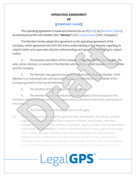Creating a Service Agreement Template: A Step-by-Step Guide
When running a business, there's a good chance you'll need to enter into contracts with service providers, contractors, or consultants. In these...
7 min read
LegalGPS : Oct. 7, 2024
Welcome, entrepreneur friend! In today's world, referrals are becoming even more essential for businesses to expand their client base and increase revenue. What better way to manage and enhance partnerships than with a well-structured referral agreement? In this guide, we will take you through everything you need to know about creating and implementing referral agreements into your business.


Secure Your Business with a Referral Agreement!
Legal GPS templates are drafted by top startup attorneys and are fully customizable🛠️.
Trusted by 1000+ businesses to close secure deals.
A referral agreement is a legal document that outlines the terms and conditions under which parties involved in a business relationship can refer potential customers or clients to one another.
For instance, a company selling web design services might collaborate with an SEO company. The web design company can then refer its clients to the SEO company for optimizing their newly-designed websites. In return, the SEO company can refer their clients to the website design firm for a design revamp.
The agreement usually provides guidelines for compensating the party that refers the customer, safeguards the referred clients or customers, and maintains confidentiality. It's essentially a win-win situation for both parties.
Referral agreements are gaining prominence due to their ability to:
Expand your client base: Partnering with like-minded businesses can help you foster a more extensive network and reach potential clients who may not be aware of your services.
Pro-Tip: You can use referral agreements to encourage your network to refer their clients for services. This helps you build a stronger and more robust customer base.
Generate more revenue: Referral agreements ensure that both parties are compensated for the referrals they send, which means more money in your pockets.
Pro-Tip: You can also use referral agreements as an incentive for existing customers who refer their friends or colleagues.
Minimize marketing costs: Since referrals are organic marketing strategies, the cost of acquiring clients is considerably lower than traditional marketing approaches.
Pro-Tip: You can use referral agreements as an opportunity to build relationships with your network. This will help you nurture those connections and create loyal customers who are likely to refer their friends and colleagues.
Maintain business professionalism: The agreement sets the standard for professionalism and transparency. It also reduces misunderstandings since both parties clearly understand their respective roles.
Pro-Tip: You can use the agreement as a way to build trust and establish credibility with your network. This will help you nurture those connections and create loyal customers who are likely to refer their friends and colleagues.
Safeguard confidential information: A well-drafted agreement may have clauses that protect sensitive information, ensuring both parties maintain confidentiality.
Pro-Tip: You should also use this document to sign non-disclosure agreements with your clients. This will help you protect sensitive information and prevent any leaks.
Now that you are aware of the benefits of a referral agreement, let's dive into how to write one that works perfectly for your business.
Begin by clearly marking the "Parties" section of your agreement. 'Party One' would be your company, while 'Party Two' would be the partner entity. Use legal names of businesses or individuals involved. Make it a point to mention their primary business addresses as well to strictly formalize the entities involved.
Party One: Shell Oil Company, located at [address]
Party Two: BP Global Ltd., located at [address]
Specify the services to be referred in detail. For instance, if it's about referring clients for an SEO service, the description should include all the services involved - from website audit to link building and reporting. Along with this, do mention any specific regions, industries, or limitations to be focused on.
|
Example "Party One is seeking to refer business owners who have a need for SEO services. We will only be referring clients within the United States at this time." |
Clearly define what constitutes successful referral in monetary terms or otherwise. You could base it on the first project the referred customer gives to the partner company, or it could be a certain percentage of their payment for a set period. Use subheadings for clarity. For example:
Payment Calculation: Explain how payment will be calculated.
Payment Timing: Specify when the payment must be made, i.e., within 30 days after the end of the month.
|
Example “Payment will be made in the form of 10% of the first project that Party One refers to Party Two. This payment will be made at the completion of the project, and any additional projects that are referred by Party One will earn an additional 5%. Payment is due within 30 days after completion of work." |
Under the section termed "Term", state how long the agreement will last before it needs to be renewed. If it's an ongoing agreement, specify that it remains in effect unless terminated by either party with a given notice period.
In the "Termination" section, list out grounds for termination. These could range from a breach of agreement, failure to pay referral fees, or if either party dissolves or ceases their primary business.
|
Example "Parties agree that this Agreement will remain in effect for a term of two years, unless terminated by either party with at least 30 days written notice. Either Party may terminate this Agreement at any time upon written notice to the other Party if the other Party breaches any material provision of this Agreement and fails to cure such breach within 30 days after receipt of such notice." |


Legal GPS Pro
Protect your business with our complete legal subscription service, designed by top startup attorneys.
The "Confidentiality" section protects sensitive data shared between parties. Include the type of information considered as confidential and the consequences of breaching this term.
An example of a confidentiality clause is:
|
Example "The parties agree that all information disclosed by one Party to the other Party, whether orally or in writing, will be treated as confidential and proprietary, and shall not be used for any purpose other than the performance of this Agreement without the prior written consent of the disclosing party." |
If you'd like to include this clause preventing the referred from competing directly with your company, describe the details here. Specify the period of non-compete and the geographical zones it applies to.
While optional, a non-compete clause is a good way to make sure that a referred employee doesn't go to work for direct competition and steal your clients. It also protects you from any liability that may arise if they start doing something illegal while working at their new job.
|
Example "The Company and Employee agree that Employee shall not engage in any business activities directly or indirectly competitive with the Company for a period of one year after the termination of his employment with Company." |
It's typically good to ensure that each party can cover their legal liabilities. A sample phrase could be, "Both parties agree to indemnify and hold harmless the other against any losses arising out of the agreement."
This is useful for a number of reasons — it can help protect the parties if something goes wrong, and it can act as a deterrent for one party to sue the other. If there is an indemnification clause in place, then a party will not be able to hold another responsible for any loss that they suffer from the contract.
|
Example "Company, its affiliates and agents shall not be liable for any loss or damage resulting from the performance of services under the agreement. In addition, Company will indemnify and hold harmless Client against any losses arising out of this agreement." |
Get Your Referral Agreement Template
with a Legal GPS Subscription
This is where you specify what happens when either party violates or breaches the contract. It could be as simple as stating that the contract will terminate if one party breaches it, or you can specify how much time each party has to remedy a breach before termination occurs. You can also include what happens if the contract is terminated by either party.
|
Example "The parties may terminate this agreement at any time by giving notice in writing to the other party. If either party is in breach of its obligations under this agreement, the other party may terminate it upon written notice specifying how long the breaching party has to remedy such breach." |
Notate which state's (or country's) laws will be used to resolve any legal disputes that may arise. You may also choose to have the contract interpreted by a specific state's (or country's) laws, in which case you should include that information here. Step 10: Signatures and Dates Notify both parties of when they need to sign the contract (usually within 30 days), and then sign it yourself or have someone else do so on your behalf.
|
Example This contract is made between [NAME OF BED & BREAKFAST], a limited liability company located at [ADDRESS] (hereinafter referred to as "Host"), and [NAME OF GUEST], a [SEX] [AGE] person who resides at an address that is the same as or different from the above-mentioned address (hereinafter referred to as "Guest"). |
Specify whether disputes will be handled through court litigation, arbitration, or mediation. For example:
|
Example "All disputes arising out of this agreement that cannot be resolved by the parties shall be submitted to mediation in accordance with the procedures of the [State] Mediation Association." |
Moreover, if you want to include a mandatory arbitration clause, specify whether the dispute will be handled through a binding or non-binding arbitration process.

Secure Your Business with a Referral Agreement!
Legal GPS templates are drafted by top startup attorneys and are fully customizable🛠️.
Trusted by 1000+ businesses to close secure deals.
Conclude your agreement with a line for each party to sign and date, thus acknowledging they've read, understood, and agreed to the contract terms. It's always a good idea to have a witness' signature as well or have the agreement notarized for solid documentation.
|
Example "This agreement is effective as of the date signed below by parties, who agree to comply with the terms and conditions set forth herein. Signed by both parties on "date", in [city], [state]." |
An effective referral agreement paves the way for a fruitful collaboration between businesses. It is the foundation for building a strong network of professionals with shared goals. This guide helps you to craft an agreement tailored to your business needs. It also fosters transparency, mutual understanding, and a harmonious business relationship.
Now that you are equipped with knowledge, it's time to put it into action. Our expertly-crafted referral agreement templates will ensure that you and your partner are on the same page and set for success. Check them out and give your business the opportunity it deserves to flourish and prosper.
The biggest question now is, "Do I need a business lawyer?” For most businesses and in most cases, you don't need a lawyer to start your business. Instead, many business owners rely on Legal GPS Pro to help with legal issues.
Legal GPS Pro is your All-In-One Legal Toolkit for Businesses. Developed by top startup attorneys, Pro gives you access to 100+ expertly crafted templates including operating agreements, NDAs, and service agreements, and an interactive platform. All designed to protect your company and set it up for lasting success.
Get Legal GPS's Referral Agreement Template Now

Legal GPS Pro
Protect your business with our complete legal subscription service, designed by top startup attorneys.
| Premium Template Single-use Template |
Legal GPS Pro Unlimited Access, Best Value |
|
|
| Get Template | Learn More |
| Trusted by 1000+ businesses | |

When running a business, there's a good chance you'll need to enter into contracts with service providers, contractors, or consultants. In these...

Running a sustainable consulting or coaching business means dealing with multiple moving parts. One key aspect of this infrastructure that often...

When it comes to the business world, nothing can quite replicate the satisfaction of a successful collaboration. However, success doesn’t just...